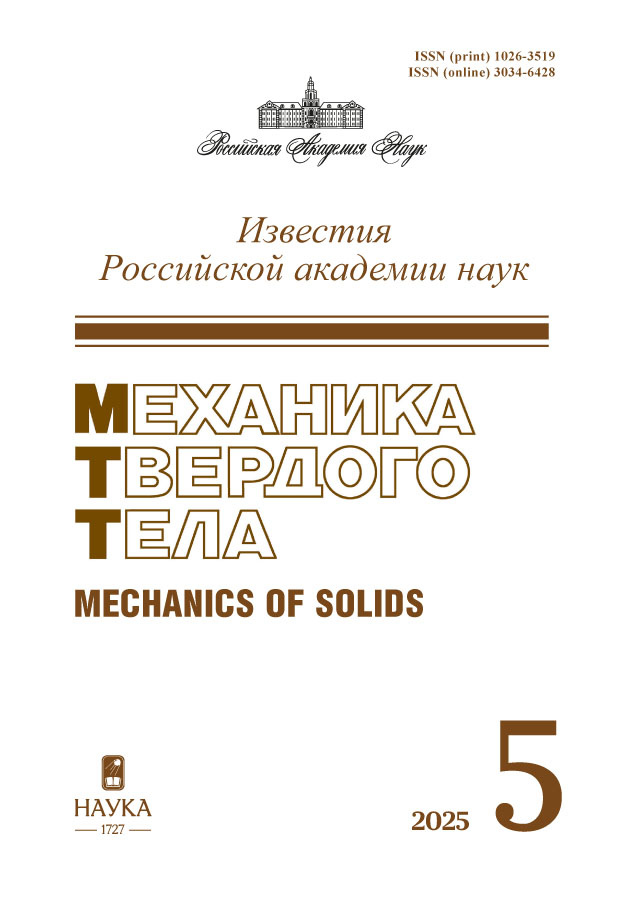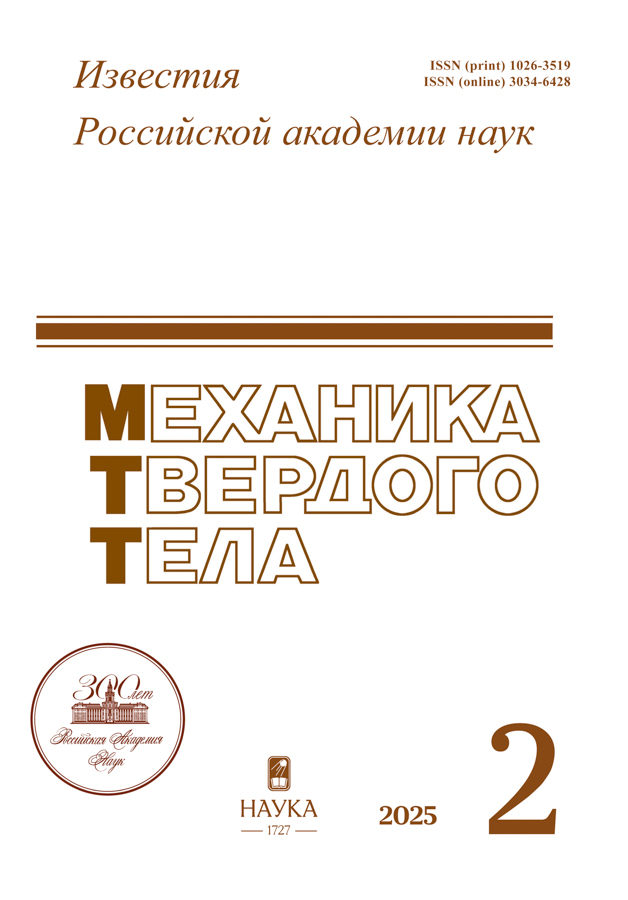Моделирование гидравлического автофретирования толстостенных цилиндрических оболочек с учетом упругопластической анизотропии, вызванной эффектом Баушингера
- Авторы: Феоктистов С.И.1, Андрианов И.К.1, Тхет Л.1
-
Учреждения:
- Федеральное государственное бюджетное образовательное учреждение высшего образования “Комсомольский-на-Амуре государственный университет”
- Выпуск: № 2 (2025)
- Страницы: 149-178
- Раздел: Статьи
- URL: https://kazanmedjournal.ru/1026-3519/article/view/686212
- DOI: https://doi.org/10.31857/S1026351925020094
- EDN: https://elibrary.ru/anmfka
- ID: 686212
Цитировать
Полный текст
Аннотация
Настоящая работа направлена на разработку метода расчета остаточных напряжений при автофретировании цилиндрических оболочек, позволяющего учитывать упругопластическую анизотропию, вызванную эффектом Баушингера. Предложенный метод расчета основан на совместном решении методом переменных параметров упругости интегральных уравнений равновесия и совместности деформаций, записанных в координатах Эйлера для нелинейных мер деформации. Результаты работы хорошо согласуются с результатами других авторов, полученными при аналогичных исходных данных.
Полный текст
Об авторах
С. И. Феоктистов
Федеральное государственное бюджетное образовательное учреждение высшего образования “Комсомольский-на-Амуре государственный университет”
Автор, ответственный за переписку.
Email: serg_feo@mail.ru
Россия, Комсомольск-на-Амуре
И. К. Андрианов
Федеральное государственное бюджетное образовательное учреждение высшего образования “Комсомольский-на-Амуре государственный университет”
Email: ivan_andrianov_90@mail.ru
Россия, Комсомольск-на-Амуре
Л. Тхет
Федеральное государственное бюджетное образовательное учреждение высшего образования “Комсомольский-на-Амуре государственный университет”
Email: linhtetnaining513028@gmail.ru
Россия, Комсомольск-на-Амуре
Список литературы
- Fryer D.M., Fryer D.M., Harvey J.F. High Pressure Vessels. Harvey, Boston: Springer, 2012. 216 p.
- Shufen R., Shufen R., Dixit U.S. A review of theoretical and experimental research on various autofrettage processes // J. Press. Vessel Technol. 2018. V. 140. № 5. P. 15.
- Малинин Н.Н. Прикладная теория пластичности и ползучести. М.: Машиностроение, 1975. 399 с.
- Kholdi M., Loghman A., Ashrafi H. Analysis of thick-walled spherical shells subjected to external pressure: Elastoplastic and residual stress analysis // Proc. Inst. Mech. Eng., Part L. 2020. V. 234. № 1. P. 186–197. https://doi.org/10.1177/1464420719882958
- Huang X.P., Cheng C.W. Autofrettage analysis of thick-walled cylinder based on tensile-compressive curve of material // Key Engineering Materials. 2004. V. 274–276. P. 1035–1040. https://doi.org/10.4028/www.scientific.net/KEM.274-276.1035
- Chen P.C.T. The Bauschinger and hardening effect on residual stresses in an autofrettaged thick-walled cylinder // J. Pressure Vessel Technol. 1986. V. 108. № 1. P. 108–112. https://doi.org/10.1115/1.3264743
- Huang X.P. A general autofrettage model of a thick-walled cylinder based on tensile–compressive stress–strain curve of a material // J. Strain Anal. Eng. Design. 2005. V. 40. № 6. P. 599–607. https://doi.org/10.1243/030932405X16070
- Hu Z., Penumarthy C. Computer modeling and optimization of swage autofrettage process of a thick-walled cylinder incorporating Bauschinger effect // American Transactions on Engineering & Applied Sciences. 2014. V. 3. № 1. P. 31–63.
- Perl M., Perry J. An experimental-numerical determination of the three-dimensional autofrettage residual stress field incorporating Bauschinger effects // J. Press. Vessel Technol. 2006. V. 128. № 2. P. 173–178. https://doi.org/10.1115/1.2172959
- Hu Z., Parker A.P. Swage autofrettage analysis – Current status and future prospects // Inter. J. Press. Vessels Piping. 2019. V. 171. P. 233–241. https://doi.org/10.1016/j.ijpvp.2019.03.007
- Zare H.R., Darijani H. A novel autofrettage method for strengthening and design of thick-walled cylinders // Mater. Des. 2016. V. 105. P. 366–374. https://doi.org/10.1016/j.matdes.2016.05.062
- Zare H.R., Darijani H. Strengthening and design of the linear hardening thickwalle cylinders using the new method of rotational autofrettage // Int. J. Mech. Sci. 2017. V. 124–125. P. 1–8. https://doi.org/10.1016/j.ijmecsci.2017.02.015
- Kamal S.M. Estimation of optimum rotational speed for rotational autofrettage of disks incorporating Bauschinger effect // Mech. Base. Des. Struct. Mach. 2020. № 50. № 7. P. 1–20. http://dx.doi.org/10.1080/15397734.2020.1780608
- Москвитин В.В. Пластичность при переменных нагружениях. М.: Изд-во МГУ, 1965. 263 с.
- Feoktistov S.I., Andrianov I.K. Analytical description of the Bauschinger effect using experimental data and the generalized Мasing principle // Mater. Phys. Mech. 2024. V. 52. № 1. P. 49–59. http://dx.doi.org/10.18149/MPM.5212024_5
- Адигамов Р.Р., Андреев В.А., Рогачев С.О., Федотов Е.С., Хадеев Г.Е., Юсупов В.С. Проявление эффекта Баушингера при знакопеременной деформации // Черная металлургия: Известия вузов. 2022. Т. 65. № 7. С. 455–466. https://doi.org/10.17073/0368-0797-2022-7-455-466
- Пыхтунова С.В. К вопросу об эффекте Баушингера // Качество в обработке материалов. 2015. № 1(3). С. 75–77.
- Нигматуллин В.И. Экспериментальное исследование влияния предварительной пластической деформации на поведение конструкционных сталей при обратном нагружении // Труды ЦНИИ им. акад. А.Н. Крылова. 2011. № 60. С. 119–132.
- Perry J., Perl M., Shneck R., Haroush S. The Influence of the Bauschinger Effect on the Yield Stress, Young’s Modulus, and Poisson’s Ratio of a Gun Barrel Steel // J. Press. Vessel Technol. 2006. V. 128. № 2. P. 179–184. https://doi.org/10.1115/1.2172962
- Dell H.D., Eliseev V.V., Shapievskaya V.A. Experimental study of the bauschinger effect for anisotropic metals // Mechanics of Solids. 2014. V. 49. № 5. P. 561–567. https://doi.org/10.3103/S0025654414050070
- Parker A.P. Characterization of steels using a revised kinematic hardening model incorporating Bauschinger effect // J. Press. Vessel Technol. 2003. V. 125. № 3. P. 277–281. https://doi.org/10.1115/1.1593071
- Hu Z., Parker A.P. Implementation and validation of true material constitutive model for accurate modeling of thick-walled cylinder swage autofrettage // Int. J. Press. Vessels and Piping. 2021. V. 191. P. 1–10. https://doi.org/10.1016/j.ijpvp.2021.104378
- Faghih S., Jahed H., Behravesh S. Variable Material Properties Approach: A Review on Twenty Years of Progress // J. Press. Vessel Technol. 2018. V. 140. № 5. P. 050803. https://doi.org/10.1115/1.4039068
- Jahed H., Dubey R.N. An Axisymmetric Method of ElasticPlastic Analysis Capable of Predicting Residual Stress Field // ASME J. Press. Vessel Technology. 1997. V. 119. № 3. P. 264–273. https://doi.org/10.1115/1.2842303
- Биргер И.А. Круглые пластинки и оболочки вращения. М.: Оборонгиз, 1961. 368 с.
- Биргер И.А., Мавлютов Р.Р. Сопротивление материалов. М.: Наука, 1986. 560 с.
- Писаренко Г.С., Можаровский Н.С. Уравнения и краевые задачи теории пластичности и ползучести. Киев: Наук. Думка, 1981. 496 с.
- Крыжевич Г.Б., Филатов А.Р. Модель упругопластического деформирования алюминиевых сплавов и критерии малоцикловой усталости конструкций // Труды Крыловского государственного научного центра. 2018. Спец. Вып. № 2. С. 85–95. https://doi.org/10.24937/2542-2324-2018-2-S-I-85-95
- Feoktistov S.I., Andrianov I.K. Method for calculating the forming limit of a pipe blank under expansion taking into account nonlinear plasticity // J. Appl. Mech. Tech. Phys. 2023. V. 64. № 4. P. 721–727. https://doi.org/10.1134/s0021894423040193
- Durban D. Large strain solution for pressurized elasto/plastic tubes // J. Appl. Mech, Trans. ASME. 1979. V. 46. № 1. P 228–230. https://doi.org/10.1115/1.3424511
- Durban D. A finite strain axially-symmetric solution for elastic tubes // Int. J. Solids Struct. 1988. V. 24. № 7. P. 675–682. https://doi.org/10.1016/0020-7683(88)90016-9
- Durban D. Finite straining of pressurized compressible elastoplastic tubes // Int. J. Eng. 1988. V. 26. № 9. P. 939–950. https://doi.org/10.1016/0020-7225(88)90023-7
- Durban D., Kubi M. A General solution for the pressurized elastoplastic tube // J. Appl. Mech. 1992. № 59. № 1. P. 20–26. https://doi.org/10.1115/1.2899431
- Феоктистов С.И. Андрианов И.К. Уравнения совместности логарифмических деформаций в координатах Эйлера для решения осесимметричных процессов обработки металлов давлением // Ученые записки Комсомольского-на-Амуре государственного технического университета. 2021. № 7 (55). С. 26–30. https://doi.org/10.17084/20764359-2021-55-26
- Durban D., Kubi M. A General solution for the pressurized elastoplastic tube // J. Appl. Mech. 1992. V. 59. № 1. P. 20–26. https://doi.org/10.1115/1.2899431
- Феоктистов С.И., Андрианов И.К., Тхет Л. Моделирование напряженно-деформированного состояния толстостенных цилиндрических оболочек с учетом физической нелинейности материала // Ученые записки Комсомольского-на-Амуре государственного технического университета. 2022. № 3 (59). С. 12–20. https://doi.org/10.17084/20764359-2022-59-12
- Andrianov I.K., Feoktistov S.I. Inverse problem of elastic-plastic deformation of a free thick-walled cylindrical shell taking into account the nonlinear law of hardening // Problems of Strength and Plasticity. 2024. V. 86. № 3. P. 259–269. https://doi.org/10.32326/1814-9146-2024-86-3-259-269
- Смирнов-Аляев Г.А. Теория автоскрепления цилиндров. М.: Оборонгиз, 1940. 284 с.
- Troiano E., Underwood J.H., Parker A.P. Finite Element Investigation of Bauschinger Effect in High-Strength A723 Pressure Vessel Steel // J. Press. Vessel Technol. 2006. V. 128. № 2. P. 185–189. https://doi.org/10.1115/1.2172616
Дополнительные файлы

































